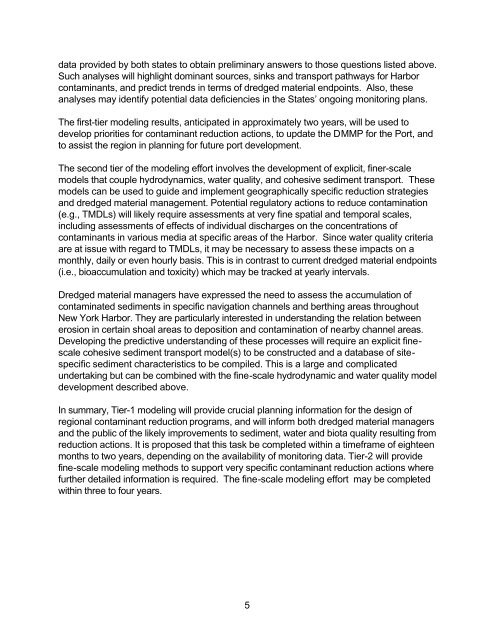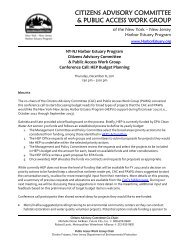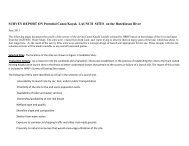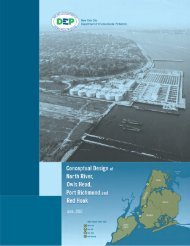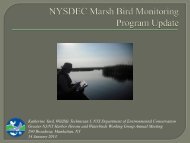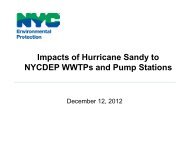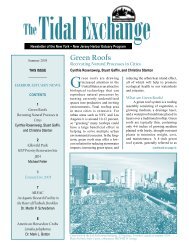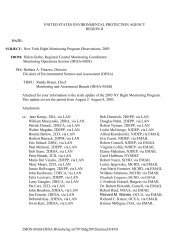A Model for the Evaluation and Management of Contaminants of ...
A Model for the Evaluation and Management of Contaminants of ...
A Model for the Evaluation and Management of Contaminants of ...
You also want an ePaper? Increase the reach of your titles
YUMPU automatically turns print PDFs into web optimized ePapers that Google loves.
data provided by both states to obtain preliminary answers to those questions listed above.<br />
Such analyses will highlight dominant sources, sinks <strong>and</strong> transport pathways <strong>for</strong> Harbor<br />
contaminants, <strong>and</strong> predict trends in terms <strong>of</strong> dredged material endpoints. Also, <strong>the</strong>se<br />
analyses may identify potential data deficiencies in <strong>the</strong> States’ ongoing monitoring plans.<br />
The first-tier modeling results, anticipated in approximately two years, will be used to<br />
develop priorities <strong>for</strong> contaminant reduction actions, to update <strong>the</strong> DMMP <strong>for</strong> <strong>the</strong> Port, <strong>and</strong><br />
to assist <strong>the</strong> region in planning <strong>for</strong> future port development.<br />
The second tier <strong>of</strong> <strong>the</strong> modeling ef<strong>for</strong>t involves <strong>the</strong> development <strong>of</strong> explicit, finer-scale<br />
models that couple hydrodynamics, water quality, <strong>and</strong> cohesive sediment transport. These<br />
models can be used to guide <strong>and</strong> implement geographically specific reduction strategies<br />
<strong>and</strong> dredged material management. Potential regulatory actions to reduce contamination<br />
(e.g., TMDLs) will likely require assessments at very fine spatial <strong>and</strong> temporal scales,<br />
including assessments <strong>of</strong> effects <strong>of</strong> individual discharges on <strong>the</strong> concentrations <strong>of</strong><br />
contaminants in various media at specific areas <strong>of</strong> <strong>the</strong> Harbor. Since water quality criteria<br />
are at issue with regard to TMDLs, it may be necessary to assess <strong>the</strong>se impacts on a<br />
monthly, daily or even hourly basis. This is in contrast to current dredged material endpoints<br />
(i.e., bioaccumulation <strong>and</strong> toxicity) which may be tracked at yearly intervals.<br />
Dredged material managers have expressed <strong>the</strong> need to assess <strong>the</strong> accumulation <strong>of</strong><br />
contaminated sediments in specific navigation channels <strong>and</strong> berthing areas throughout<br />
New York Harbor. They are particularly interested in underst<strong>and</strong>ing <strong>the</strong> relation between<br />
erosion in certain shoal areas to deposition <strong>and</strong> contamination <strong>of</strong> nearby channel areas.<br />
Developing <strong>the</strong> predictive underst<strong>and</strong>ing <strong>of</strong> <strong>the</strong>se processes will require an explicit finescale<br />
cohesive sediment transport model(s) to be constructed <strong>and</strong> a database <strong>of</strong> sitespecific<br />
sediment characteristics to be compiled. This is a large <strong>and</strong> complicated<br />
undertaking but can be combined with <strong>the</strong> fine-scale hydrodynamic <strong>and</strong> water quality model<br />
development described above.<br />
In summary, Tier-1 modeling will provide crucial planning in<strong>for</strong>mation <strong>for</strong> <strong>the</strong> design <strong>of</strong><br />
regional contaminant reduction programs, <strong>and</strong> will in<strong>for</strong>m both dredged material managers<br />
<strong>and</strong> <strong>the</strong> public <strong>of</strong> <strong>the</strong> likely improvements to sediment, water <strong>and</strong> biota quality resulting from<br />
reduction actions. It is proposed that this task be completed within a timeframe <strong>of</strong> eighteen<br />
months to two years, depending on <strong>the</strong> availability <strong>of</strong> monitoring data. Tier-2 will provide<br />
fine-scale modeling methods to support very specific contaminant reduction actions where<br />
fur<strong>the</strong>r detailed in<strong>for</strong>mation is required. The fine-scale modeling ef<strong>for</strong>t may be completed<br />
within three to four years.<br />
5


